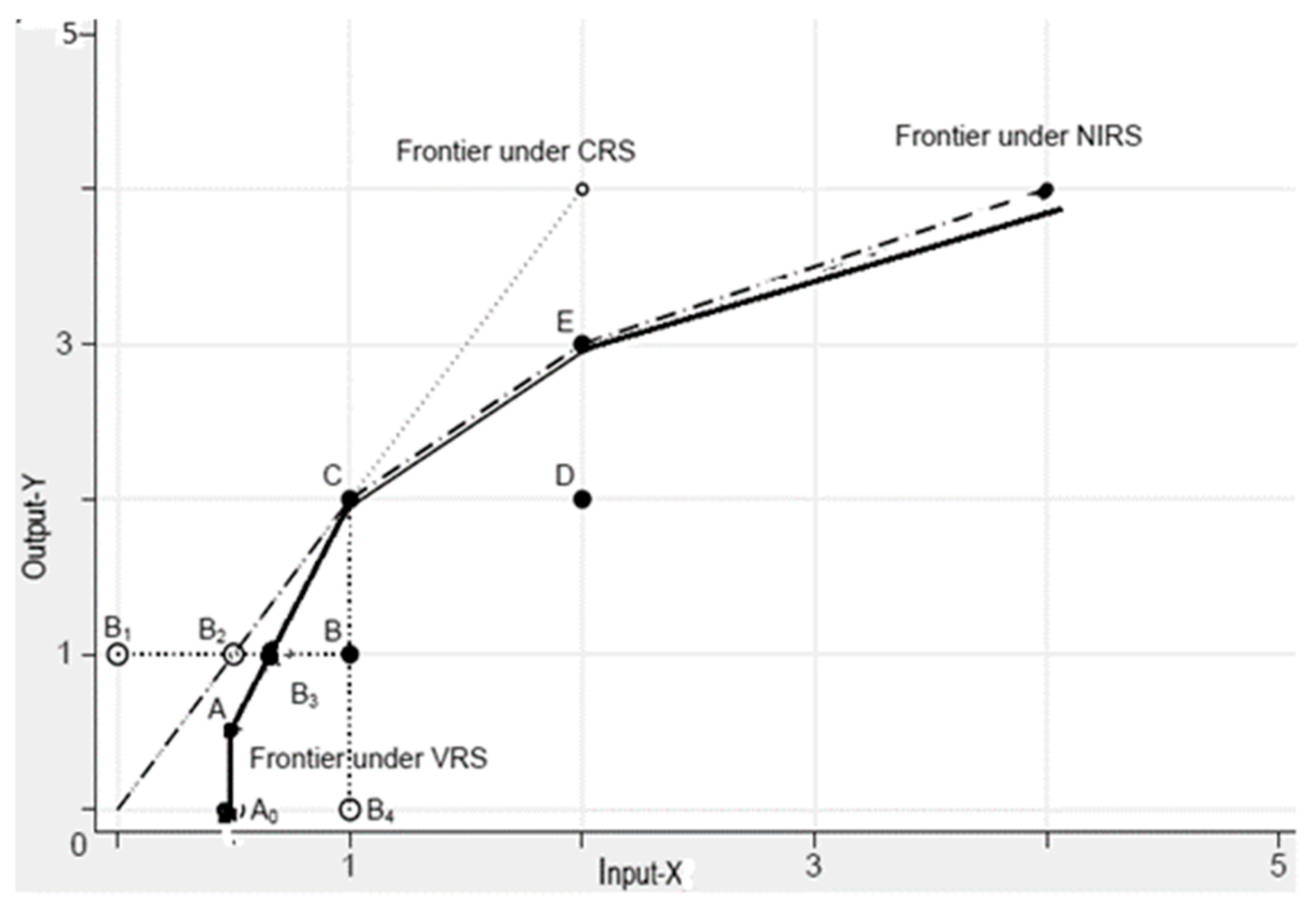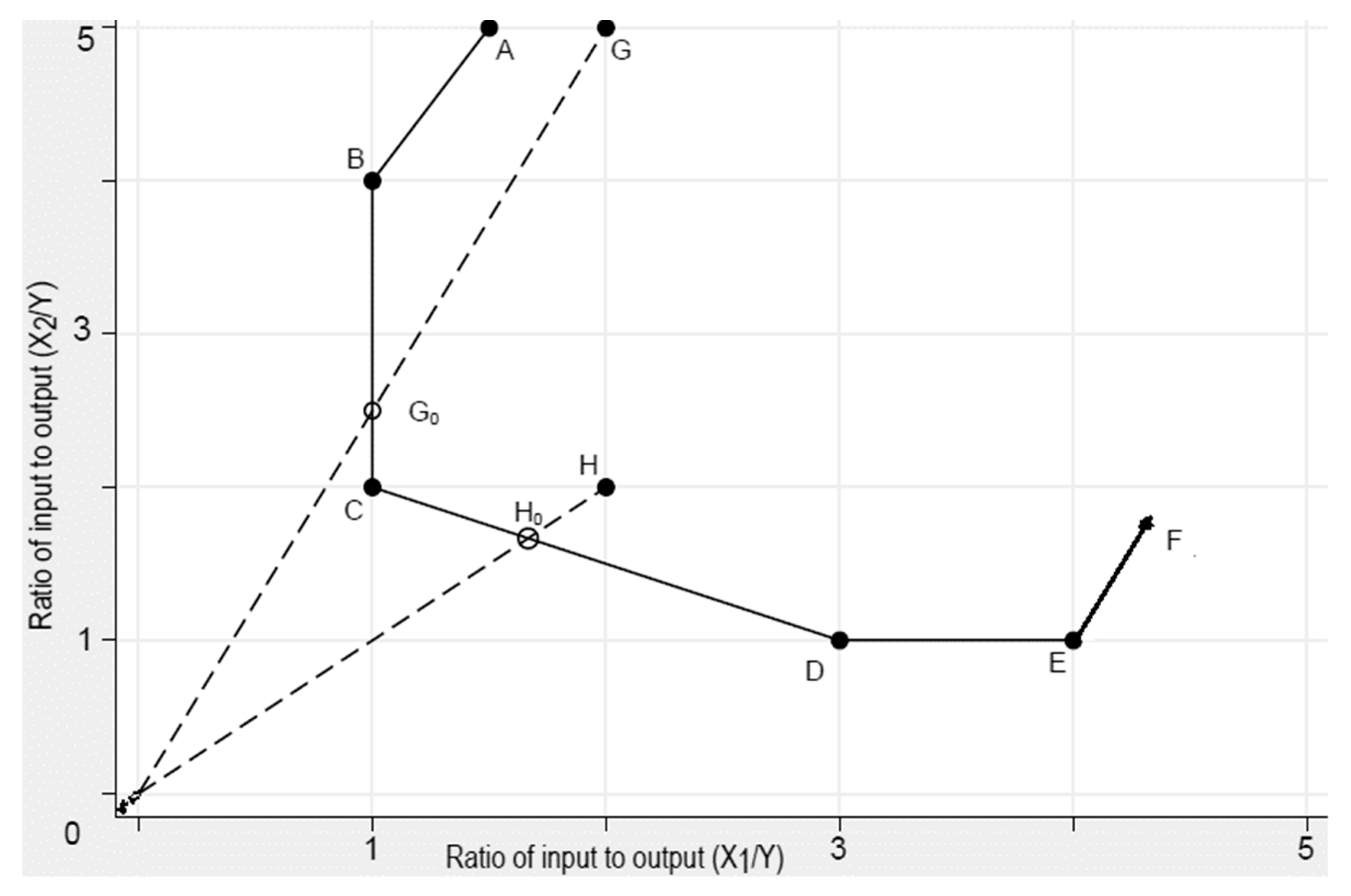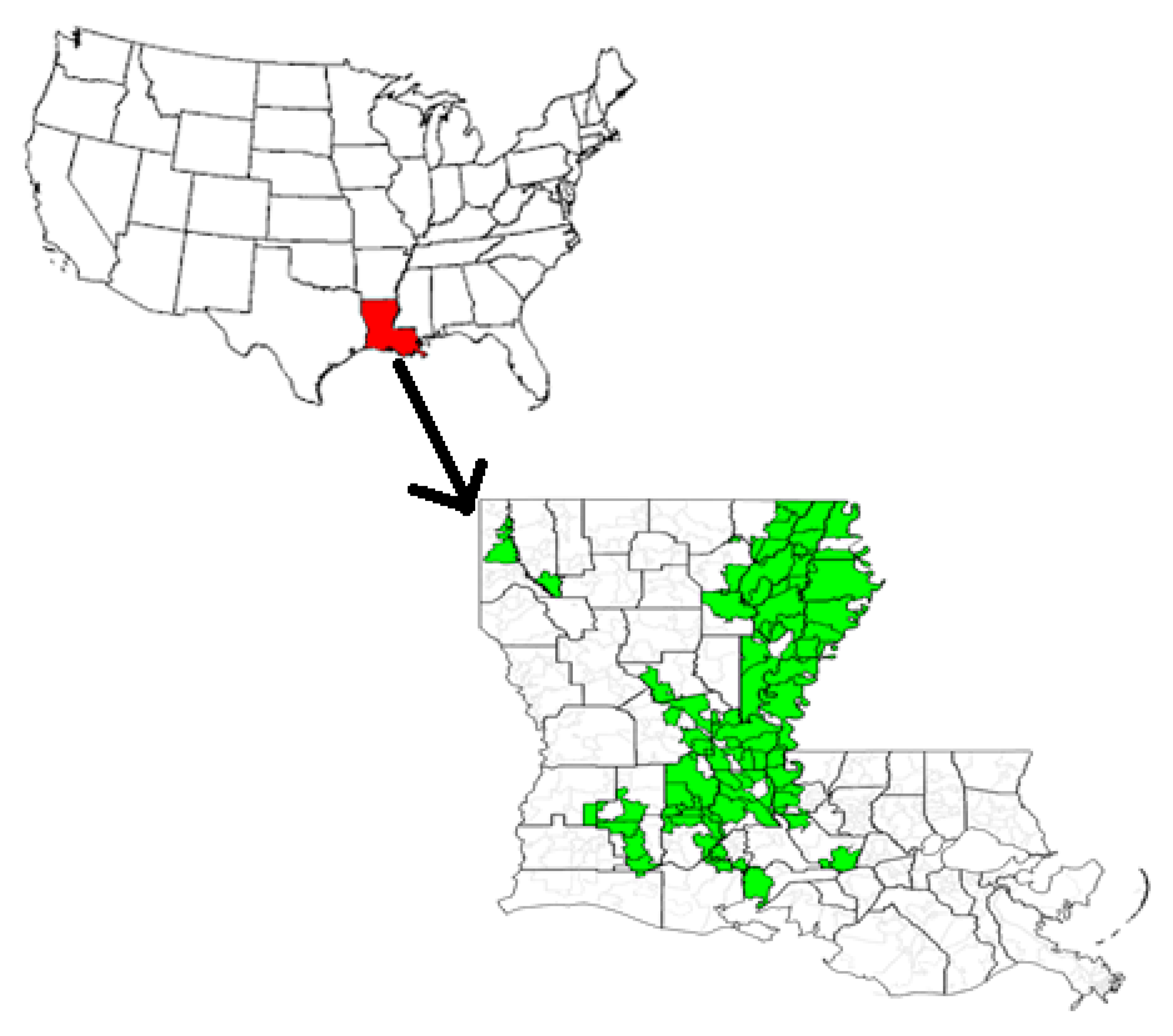An Evaluation of Irrigation Water Use Efficiency in Crop Production Using a Data Envelopment Analysis Approach: A Case of Louisiana, USA
Abstract
1. Introduction
2. Literature Review
3. Method
DEA Method
4. Data Description
5. Results and Discussion
6. Concluding Remarks
Author Contributions
Funding
Acknowledgments
Conflicts of Interest
References
- Ali, M.; Talukder, M. Increasing water productivity in crop production—A synthesis. Agric. Water Manag. 2008, 95, 1201–1213. [Google Scholar] [CrossRef]
- Armstrong, D.P. Water use efficiency and profitability on an irrigated dairy farm in northern Victoria: A case study. Aust. J. Exp. Agric. 2004, 44, 137–144. [Google Scholar] [CrossRef]
- Spencer, G.; Krutz, L.J.; Falconer, L.L.; Henry, W.B.; Henry, C.G.; Larson, E.J.; Pringle, H.C.; Bryant, C.J.; Atwill, R.L. Irrigation Water Management Technologies for Furrow-Irrigated Corn that Decrease Water Use and Improve Yield and On-Farm Profitability. CFTM 2019, 5, 180100. [Google Scholar] [CrossRef]
- Amosson, S.; Almas, L.; Girase, J.R.; Kenny, N.; Guerrero, B.; Vimlesh, K.; Marek, T. Economics of Irrigation Systems. Texas A&M Agrilife Extension, College Station, TX, B-6113. 2011. Available online: https://aglifesciences.tamu.edu/baen/wp-content/uploads/sites/24/2017/01/B-6113-Economics-of-Irrigation-Systems.pdf (accessed on 10 February 2020).
- Guerrero, B.; Amosson, S.; Almas, L.; Marek, T.; Porter, D. Economic Feasibility of Converting Center Pivot Irrigation to Subsurface Drip Irrigation. J. ASFMRA 2016, 77–88. Available online: https://www.asfmra.org/resources/asfmra-journal/journal-archives (accessed on 9 February 2020).
- Sargent, B.P. Water use in Louisiana, 2010. Louisiana Department of Transportation and Development, Special Report No. 17 (Revised December 2012). 2012. Available online: https://www.landcan.org/pdfs/WaterUse2010.pdf. (accessed on 12 November 2020).
- Peterson, J.M.; Ding, Y. Economic Adjustments to Groundwater Depletion in the High Plains: Do Water-Saving Irrigation Systems Save Water? Am. J. Agric. Econ. 2005, 87, 147–159. [Google Scholar] [CrossRef]
- Paudel, K.P.; Limaye, A.S.; Hatch, L.U.; Cruise, J.F.; Musleh, F. Development of an optimal water allocation decision tool for the major crops during the water deficit period in the southeast united states. Nat. Resour. Model. 2008, 18, 281–306. [Google Scholar] [CrossRef]
- Knox, J.W.; Kay, M.; Weatherhead, E. Water regulation, crop production, and agricultural water management—Understanding farmer perspectives on irrigation efficiency. Agric. Water Manag. 2012, 108, 3–8. [Google Scholar] [CrossRef]
- Vico, G.; Porporato, A. From rainfed agriculture to stress-avoidance irrigation: II. Sustainability, crop yield, and profitability. Adv. Water Resour. 2011, 34, 272–281. [Google Scholar] [CrossRef]
- Pereira, H.; Marques, R.C. An analytical review of irrigation efficiency measured using deterministic and stochastic models. Agric. Water Manag. 2017, 184, 28–35. [Google Scholar] [CrossRef]
- Sayin, B.; Yilmaz, I.; Yılmaz, I. Comparing the Relative Efficiency of Irrigation Unions in Antalya, Turkey: A Data Envelopment Analysis. Water Econ. Policy 2015, 1, 1450005. [Google Scholar] [CrossRef]
- Lansink, A.O.; Ondersteijn, C. Energy Productivity Growth in the Dutch Greenhouse Industry. Am. J. Agric. Econ. 2006, 88, 124–132. [Google Scholar] [CrossRef]
- Dhungana, B.R.; Nuthall, P.L.; Nartea, G.V. Measuring the economic inefficiency of Nepalese rice farms using data envelopment analysis. Aust. J. Agric. Resour. Econ. 2004, 48, 347–369. [Google Scholar] [CrossRef]
- Watto, M.A.; Mugera, A.W. Efficiency of irrigation water application in sugarcane cultivation in Pakistan. J. Sci. Food Agric. 2014, 95, 1860–1867. [Google Scholar] [CrossRef] [PubMed]
- Wang, G.; Lin, N.; Zhou, X.; Li, Z.; Deng, X. Three-Stage Data Envelopment Analysis of Agricultural Water Use Efficiency: A Case Study of the Heihe River Basin. Sustain. 2018, 10, 568. [Google Scholar] [CrossRef]
- Ren, C.; Li, R.H.; Guo, P. Two-Stage DEA Analysis of Water Resource Use Efficiency. Sustainability 2016, 9, 52. [Google Scholar] [CrossRef]
- Gadanakis, Y.; Bennett, R.; Park, J.; Areal, F.J. Improving productivity and water use efficiency: A case study of farms in England. Agric. Water Manag. 2015, 160, 22–32. [Google Scholar] [CrossRef]
- Ntantos, P.N.; Karpouzos, D.K. Application of data envelopment analysis and performance indicators to irrigation systems in Thessaloniki Plain (Greece). Int. J. Eng.Nat. Sci. 2010, 4, 133–139. [Google Scholar]
- Ali, K.; Klein, K.K. Water Use Efficiency and Productivity of the Irrigation Districts in Southern Alberta. Water Resour. Manag. 2014, 28, 2751–2766. [Google Scholar] [CrossRef]
- Liu, J.; Zhang, J.; Fu, Z. Tourism eco-efficiency of Chinese coastal cities – Analysis based on the DEA-Tobit model. Ocean Coast. Manag. 2017, 148, 164–170. [Google Scholar] [CrossRef]
- Goyal, J.; Kaur, H.; Aggarwal, A. Investigating the Technical and Scale Efficiencies of Indian Textile Industry: A Target Setting Based Analysis through DEA. IUP J. Oper. Manag. 2017, 16, 16–38. [Google Scholar]
- Watkins, K.B.; Hristovska, T.; Mazzanti, R.; Wilson, C.E.; Schmidt, L. Measurement of Technical, Allocative, Economic, and Scale Efficiency of Rice Production in Arkansas Using Data Envelopment Analysis. J. Agric. Appl. Econ. 2014, 46, 89–106. [Google Scholar] [CrossRef]
- Watkins, K.B.; Henry, C.G.; Hardke, J.T.; Mane, R.U.; Mazzanti, R.; Baker, R. Efficiency Measurement of Irrigation Water and Other Inputs in Arkansas Rice Production Using Data from the Rice Research Verification Program. In BR Wells Arkansas Rice Research Studies; Norman, R.J., Moldenhauer, K.A.K., Eds.; University of Arkansas System Division of Agriculture: Fayetteville, AR, USA, 2019; Volume 659, pp. 424–430. [Google Scholar]
- Watkins, K.B.; Henry, C.G.; Hardke, J.T.; Mane, R.U.; Mazzanti, R.; Baker, R. Effects of Field Characteristics on Irrigation Water Efficiency in Arkansas Rice Production. In BR Wells Arkansas Rice Research Studies; Norman, R.J., Moldenhauer, K.A.K., Eds.; University of Arkansas System Division of Agriculture: Fayetteville, AR, USA, 2018; Volume 659, pp. 431–438. [Google Scholar]
- Charnes, A.; Cooper, W.W.; Rhodes, E. Measuring the efficiency of decision making units. Eur. J. Oper. Res. 1978, 2, 429–444. [Google Scholar] [CrossRef]
- Banker, R.D.; Charnes, A.; Cooper, W.W. Some Models for Estimating Technical and Scale Inefficiencies in Data Envelopment Analysis. Manag. Sci. 1984, 30, 1078–1092. [Google Scholar] [CrossRef]
- Lee, C. An Efficient Data Envelopment Analysis with Large Data Set in Stata. Stata J. 2010, 10, 267–280. [Google Scholar]
- Farrell, M.J. The measurement of productive efficiency. J. R. Stat. Soc. Series A 1957, 120, 253–281. [Google Scholar] [CrossRef]
- Cooper, W.W.; Seiford, L.M.; Tone, K. Introduction to Data Envelopment Analysis and Its Uses: With DEA-Solver Software and References; Springer Science & Business Media: New York, NY, USA, 2006. [Google Scholar]
- Coelli, T.; Rao, D.S.P.; Battese, G.E. An Introduction to Efficiency and Productivity Analysis; Springer Science and Business Media LLC: New York, NY, USA, 1998. [Google Scholar]
- Färe, R.; Lovell, C.K. Measuring the technical efficiency of production. J. Econ. Theory 1978, 19, 150–162. [Google Scholar] [CrossRef]
- Badunenko, O.; Mozharovskyi, P. Nonparametric Frontier Analysis Using Stata. Stata J. Promot. Commun. Stat. Stata 2016, 16, 550–589. [Google Scholar] [CrossRef]
- Dolnicar, S.; Hurlimann, A.; Grün, B. Water conservation behavior in Australia. J. Environ. Manag. 2012, 105, 44–52. [Google Scholar] [CrossRef]
- Gautam, T.K. Three Essays on Irrigation Water Management in Louisiana Crop Production. LSU Dr. Diss. 2019. Available online: https://digitalcommons.lsu.edu/gradschool_dissertations/4893 (accessed on 10 February 2020).



| Variable | Variable Description | Mean | Standard Deviation (SD) |
|---|---|---|---|
| YIELD | Per acre soybean yield (bushel) | 58.26 | 9.20 |
| WATER | Water applied per acre (in 1000 gallons) | 109.50 | 128.64 |
| LABPOC | Labor and poly pipe cost per acre in dollar | 26.19 | 30.01 |
| REPCOS | Total repair and maintenance cost in dollar | 2807.29 | 4984.19 |
| ENGC | Per acre energy cost in dollar | 24.64 | 24.64 |
| ACRE | Acres of irrigated farm | 321.10 | 421.49 |
| WELLSIZE | Well size in inch | 9.48 | 2.83 |
| Method | Radial TE (Farrell Measure) | Nonradial TE (Russell Measure) | ||
|---|---|---|---|---|
| VRS | NIRS | VRS | NIRS | |
| Input-based | 0.8352 | 0.7951 | 0.6225 | 0.5892 |
| Output-based | 1.1250 | 1.1417 | 1.1250 | 1.1417 |
| Type of DEA | Base | RTS | Mean | SD |
|---|---|---|---|---|
| Radial TE (Farrell measure) | Input-based | VRS | 0.8352 | 0.1843 |
| CRS | 0.7493 | 0.2075 | ||
| NIRS | 0.7951 | 0.2000 | ||
| Output-based | VRS | 1.1250 | 0.2020 | |
| CRS | 1.4749 | 0.5490 | ||
| NIRS | 1.1417 | 0.1997 | ||
| Nonradial TE (Russell measure) | Input-based | VRS | 0.6225 | 0.2302 |
| CRS | 0.5295 | 0.2262 | ||
| NIRS | 0.5892 | 0.2389 | ||
| Output-based | VRS | 1.1250 | 0.2020 | |
| CRS | 1.4749 | 0.5490 | ||
| NIRS | 1.1417 | 0.1997 |
| Base | RTS | Mean TE | SD | SE |
|---|---|---|---|---|
| Output-based measure of TE | VRS | 1.125 | 0.202 | - |
| CRS | 1.475 | 0.549 | 1.300 | |
| NIRS | 1.142 | 0.200 | 1.017 | |
| Input-based measure of TE | VRS | 0.835 | 0.184 | - |
| CRS | 0.749 | 0.207 | 0.898 | |
| NIRS | 0.795 | 0.200 | 0.949 |
| Input/Output Based Indicator Variable | Indicator Variable if Statistically Efficient/Inefficient | |||
|---|---|---|---|---|
| Scale Efficient | Scale Inefficient | Scale Inefficient Due to IRS | Scale Inefficient Due to DRS | |
| Output-based number of vars. | 79 | 4 | 1 | 3 |
| Input-based number of vars. | 83 | 0 | - | - |
Publisher’s Note: MDPI stays neutral with regard to jurisdictional claims in published maps and institutional affiliations. |
© 2020 by the authors. Licensee MDPI, Basel, Switzerland. This article is an open access article distributed under the terms and conditions of the Creative Commons Attribution (CC BY) license (http://creativecommons.org/licenses/by/4.0/).
Share and Cite
Gautam, T.K.; Paudel, K.P.; Guidry, K.M. An Evaluation of Irrigation Water Use Efficiency in Crop Production Using a Data Envelopment Analysis Approach: A Case of Louisiana, USA. Water 2020, 12, 3193. https://doi.org/10.3390/w12113193
Gautam TK, Paudel KP, Guidry KM. An Evaluation of Irrigation Water Use Efficiency in Crop Production Using a Data Envelopment Analysis Approach: A Case of Louisiana, USA. Water. 2020; 12(11):3193. https://doi.org/10.3390/w12113193
Chicago/Turabian StyleGautam, Tej K., Krishna P. Paudel, and Kurt M. Guidry. 2020. "An Evaluation of Irrigation Water Use Efficiency in Crop Production Using a Data Envelopment Analysis Approach: A Case of Louisiana, USA" Water 12, no. 11: 3193. https://doi.org/10.3390/w12113193
APA StyleGautam, T. K., Paudel, K. P., & Guidry, K. M. (2020). An Evaluation of Irrigation Water Use Efficiency in Crop Production Using a Data Envelopment Analysis Approach: A Case of Louisiana, USA. Water, 12(11), 3193. https://doi.org/10.3390/w12113193






